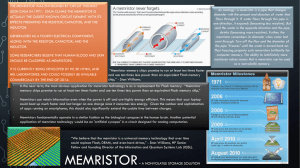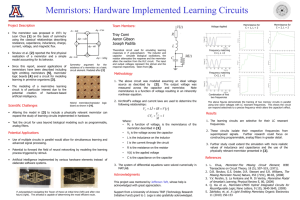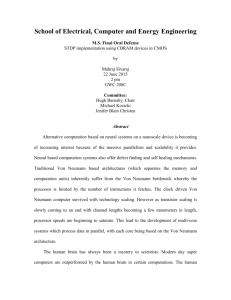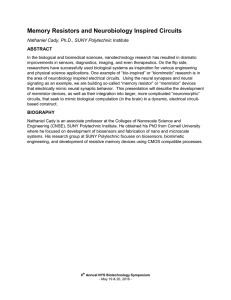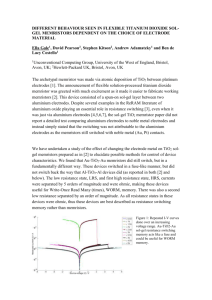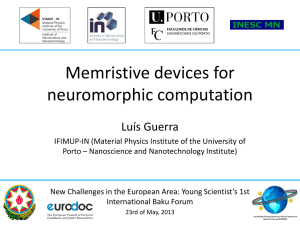Research on memristor and LDR memristor mathematic models
advertisement
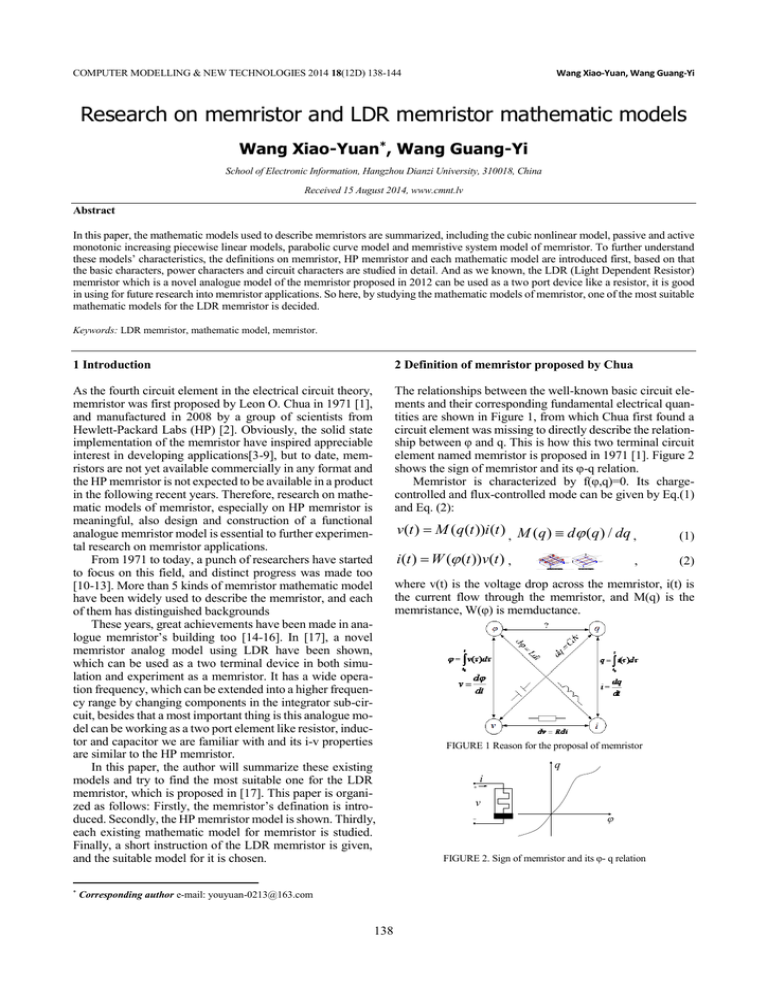
Wang Xiao-Yuan, Wang Guang-Yi COMPUTER MODELLING & NEW TECHNOLOGIES 2014 18(12D) 138-144 Research on memristor and LDR memristor mathematic models Wang Xiao-Yuan*, Wang Guang-Yi School of Electronic Information, Hangzhou Dianzi University, 310018, China Received 15 August 2014, www.cmnt.lv Abstract In this paper, the mathematic models used to describe memristors are summarized, including the cubic nonlinear model, passive and active monotonic increasing piecewise linear models, parabolic curve model and memristive system model of memristor. To further understand these models’ characteristics, the definitions on memristor, HP memristor and each mathematic model are introduced first, based on that the basic characters, power characters and circuit characters are studied in detail. And as we known, the LDR (Light Dependent Resistor) memristor which is a novel analogue model of the memristor proposed in 2012 can be used as a two port device like a resistor, it is good in using for future research into memristor applications. So here, by studying the mathematic models of memristor, one of the most suitable mathematic models for the LDR memristor is decided. Keywords: LDR memristor, mathematic model, memristor. 1 Introduction 2 Definition of memristor proposed by Chua As the fourth circuit element in the electrical circuit theory, memristor was first proposed by Leon O. Chua in 1971 [1], and manufactured in 2008 by a group of scientists from Hewlett-Packard Labs (HP) [2]. Obviously, the solid state implementation of the memristor have inspired appreciable interest in developing applications[3-9], but to date, memristors are not yet available commercially in any format and the HP memristor is not expected to be available in a product in the following recent years. Therefore, research on mathematic models of memristor, especially on HP memristor is meaningful, also design and construction of a functional analogue memristor model is essential to further experimental research on memristor applications. From 1971 to today, a punch of researchers have started to focus on this field, and distinct progress was made too [10-13]. More than 5 kinds of memristor mathematic model have been widely used to describe the memristor, and each of them has distinguished backgrounds These years, great achievements have been made in analogue memristor’s building too [14-16]. In [17], a novel memristor analog model using LDR have been shown, which can be used as a two terminal device in both simulation and experiment as a memristor. It has a wide operation frequency, which can be extended into a higher frequency range by changing components in the integrator sub-circuit, besides that a most important thing is this analogue model can be working as a two port element like resistor, inductor and capacitor we are familiar with and its i-v properties are similar to the HP memristor. In this paper, the author will summarize these existing models and try to find the most suitable one for the LDR memristor, which is proposed in [17]. This paper is organized as follows: Firstly, the memristor’s defination is introduced. Secondly, the HP memristor model is shown. Thirdly, each existing mathematic model for memristor is studied. Finally, a short instruction of the LDR memristor is given, and the suitable model for it is chosen. The relationships between the well-known basic circuit elements and their corresponding fundamental electrical quantities are shown in Figure 1, from which Chua first found a circuit element was missing to directly describe the relationship between φ and q. This is how this two terminal circuit element named memristor is proposed in 1971 [1]. Figure 2 shows the sign of memristor and its φ-q relation. Memristor is characterized by f(φ,q)=0. Its chargecontrolled and flux-controlled mode can be given by Eq.(1) and Eq. (2): * Corresponding author e-mail: youyuan-0213@163.com 138 v(t ) M (q(t ))i (t ) , M (q ) d (q ) / dq , (1) i (t ) W ( (t ))v(t ) , (2) pressure of longitudinal reinfocrement pin bolt force of tenons PBL reinforce steel concrete tenon , longitudinal reinforcement pin bolt force of tenons stirrups intersection shear force ce steel resistencce of stirrups PBH te tenon concreintersection reinfor intersection shear force stiffener ribs with hole shear force stiffener ribs with hole intersection shear force intersection shear force intersection shear force intersection shear force intersection shear force intersection shear force resistance of reinforce steel skeleton resistance of reinforce steel skeleton pin bolt force of tenons pin bolt force of tenons intersection shear force pin bolt force of tenonspin bolt force of tenons where v(t) is the voltage drop across the memristor, i(t) is the current flow through the memristor, and M(q) is the memristance, W(φ) is memductance. FIGURE 1 Reason for the proposal of memristor q i + v _ FIGURE 2. Sign of memristor and its φ- q relation Wang Xiao-Yuan, Wang Guang-Yi COMPUTER MODELLING & NEW TECHNOLOGIES 2014 18(12D) 138-144 3 HP memristor as bellow [9, 18-21]: q( ) 3 , HP memristor indeed belongs to the category of chargecontrolled memristor as shown in Figure 3. A partially doped titanium dioxide thin film with platinum electrodes make the memristance value of this nano-sized solid-state memristor influenced by the inner particle’s moving process, and by simplifying the case of ohmic electronic conduction and linear ionic drift in a uniform field with average ion mobility , the following results are obtained: w(t ) v q(t ) RON D , M (q) ROFF (1 q(t )v RON D ) , 2 and according to Eq. (1), we can obtain the memconductance formula as: W () dq() / d 3 2 , where α, β are positive. Similarly, the charge-controlled memristor cubic nonlinear model and its memristance are given by: (3) (q) q q3 , (8) (4) M (q) d (q) / dq 3q 2 (9) (5) where λ, γ are positive. From Eq.(6)- (9), we can see that different types of cubic nonlinear memristor models are similar in form, and have homologous character, so next we will use the flux-controlled memristor as a example to analyze the cubic nonlinear memristor model’s characteristics. (1) Basic characteristic Based on Eq.(6) and (7), the charge-flux relation and the memconductance-flux relation of the cubic nonlinear model of flux-controlled memrisor are shown in Fig.5, and from the W-φ relation we can see that one memconductance value corresponds to two different flux in this model. where D is the total width of the titanium dioxide film, w(t) is the width of the region of high dopant concentration on the titanium dioxide film, ROFF and RON are the limit values of the memristor resistance for w(t)=0 and w(t)=D. A w V doped (7) undoped D FIGURE 3 The structure of HP memristor q ( ) A remarkable difference with any traditional elements circuit characteristics of HP memristor is when a sinusoidal wave applied to a HP memristor, the current versus voltage relationship will be a pinched loop as shown in Fig. 4. W ( ) M ( w) RON w(t ) D ROFF (1 w(t ) D) , (6) 4 Mathematic models of memristor FIGURE 5 q-φ and W-φ relationships inside the cubic nonlinearity fluxcontrolling memristor Current(×10-3) 10 5 Change Several different types of mathematic model have been using to describe memristor and HP memristor in recent years, in chronological order the models can be listed as: the cubic nonlinear model, the monotonic increasing and picewise linear function model, parabolic curve model and the memristive system model. Next, each of these models will be introduced in detail. (2) Power characteristic The instantaneous power consumes on the flux-controlled cubic nonlinear model of memristor is: p(t ) v(t ) 2 W ( ) v(t ) 2 ( 3 2 ) , Obviously, the right hand of Eq.(10) is always greater than or equal to zero, and for any time t ≥ t0, the following equation is satisfied: 0.6 0.4 0.2 0.0 0 Flux (10) 50 10ω0 -5 ω0 -10 -1.0 -0.5 0.0 Voltage t t0 0.5 p( )d 0 , (11) which implies the cubic slippery nonlinear model of fluxcontrolled memristor is passive . (3) Circuit characteristic It is well-known that a v-i relation with “8” shape will come out when a sinusoidal wave as the input signal applied to the HP memristor. So here, by adding a sine signal to the cubic memristor model, we can get the v-i curve as shown in fig.6, in which the special pinched loop character is shown, and the loops become much more narrower when the frequency of the input signal is higher, which indicates that the cubic model of memristor has the same circuit 1.0 FIGURE 4 i-v relationship of the HP memristor [2] 4.1 CUBIC NONLINEAR MODEL The cubic nonlinear model is the most popular one, the most simply one, also the most frequency using one in the memristor theoretical research. As we known, memristor has two types, the flux-controlled type and the charge controlled type. In this model, the flux-controlled memristor is shown 139 Wang Xiao-Yuan, Wang Guang-Yi COMPUTER MODELLING & NEW TECHNOLOGIES 2014 18(12D) 138-144 characteristics as the HP memristor. During the simulation, we found that the value of α, β influence the pinched loop so much, which are manifest as: under the same amplitude and frequency sine wave as input signal, much more smaller α, β are, much wider the v-i pinched loops are, vice versa. The cubic nonlinear model of memristor is widely used mainly because of the following reasons: Firstly, the q-φ relation of this model is much similar as it described in Fig.2. Secondly, not only from the mathematical description, also from the optical point of view, this cubic model is the simplest one which can be used to describe the pinched loop relation between charge and flux of a HP memristor. Thirdly, using this model to instead of the nonlinear diode with picewise linear character in the Chua’s circuit, the steadier chaotic phenomenon can be obtained. between the charge and flux, and the W-φ relation shows different fluxes generate only two different constant memconductance values in this model. So these properties are not in accordance with the HP memristor, but not against the character of the definition of memristor. (2) Power characteristic The instantaneous power consumes on the memristor in PMIPL model is: t t0 + 1 , (16) because c and d are positive, in any case the instantaneous power consumes on the memristor describe by the PMIPL model will be greater than or equal to zero. So we can get: i 1 2 cv (t ) , p(t ) v(t ) W ( ) 2 dv(t ) , 2 p ( )d 0 , (17) Therefore the memristor model described by Eq.(14) and (15) are passive. v _ q W() d d -1 FIGURE 6 I-V characteristics of cubic nonlinearity model for fluxcontrolling memristor, when unit amplitude and different frequency sine wave applied to it c 0 1 d 4.2 PASSIVE MONOTONIC INCREASING AND PIECEWISE LINEAR (PMIPL)MODEL OF MEMRISTOR M (q) d (q) a, q 1 , dq b , q 1 W ( ) dq( ) c, 1 , d d , 1 0 1 (3) Circuit characteristic When an external voltage v(t) is applied to the PMIPL model of memristor, the current flows through it will be: i v(t )W ( ) v(t ) (12) dq( ) cv (t ), 1 , (18) d dv ( t ), 1 When v(t) is a sinusoidal wave, the current and voltage time series in the PMIPL memristor model is shows as Fig.8, and from Fig.9 we can see the i-v relation in this model is a pinched loop. Because the current flow through the memristor is controlled by flux, we can see there are mutation current waves in Fig.8 (a), which happen at special points, where the currents are not proportional to the input voltage but jump directly to another state instead according to Eq.(18). Such a mutation results in the unsmooth pinched loop happens in Fig. 9. (13) and the flux-controlled memristor of this model is: q( ) d 0.5(c d )( 1 1 ), -1 FIGURE 7 q-φ and W-φ relations inside monotone increasing and piecewise-linear passive flux-controlling memristor Passive monotonic increasing and piecewise linear model, which is proposed firstly in 2010[22], the charge-controlled memristor under this model is described as: (q) bq 0.5(a b)( q 1 q 1 ), c (14) (15) where the a, b, c and d are positive. On the account of the symmetry of the charge-controlled and flux-controlled model above, during the following study, the flux controlled model is used as a example helping to analysis this kind of memristor mathematic model. (1) Basic characteristic In this model the relation between charge-flux and memconduction-flux is \shown in Fig.7, from which we can see this model displays directly the nonlinear relation 140 FIGURE 8 Current goes through and voltage across the PMIPL model for passive flux-controlling memristor Wang Xiao-Yuan, Wang Guang-Yi COMPUTER MODELLING & NEW TECHNOLOGIES 2014 18(12D) 138-144 q q d-G i(t) + c-G -1 0 1 c-G -1 d-G (b) (a) W() 0 -1 c-G FIGURE 9 i-v characteristics of PMIPL model for flux- controlling memristor d-G (c) 4.3. ACTIVE MONOTONIC INCREASING AND PIECEWISE LINEAR (AMIPL) MODEL OF MEMRISTOR v _ + i + v v 1 _ V1=M(q)i _ + _ v _ V=M(q)i i i 1 + 1 c-G (d) Because c, d, G are passive, so only when c-G or d-G are less than zero, or their summation is positive during t0 to t, we can obtain that at any time t≥t0, the AMIPL model of memristor can be obtained by the way in Fig.10. i=W( )v FIGURE 10 AMIPL model for flux-controlling memristor which consists of a passive memristor and a -G or a -R In the following study, we will take the flux-control memristor for example to analyze this kind of model. According to the current node equation, we can derivate the relation between the flux and the charge in the AMIPL model: t t0 p ( )d 0 , (22) (3) Circuit characteristic When a sine wave signal as input power applied to this active memristor, we can obtain the current and the input signal series in Fig.12, and because of the suddenly change of the conductance happened in Fig. 11 (c) and (d), we can see the i-v characteristic is an unsmooth pinched loop in Fig.13. q( ) i ( )d (i1 ( ) i2 ( ))d (W ( )v Gv)d . (19) d 0.5(c d )( 1 1 ) G 0 -1 2 (c G)v(t ) , 1 p(t ) v(t ) W ( ) 2 (d G)v(t ) , 1 , (21) _ (W ( ) G )vd (W ( ) G )d 2 i v i1=W( )v d-G (2) Power characteristic The instantaneous power consumes on the AMIPL model of memristor is: 2 -G W() 1 FIGURE 11 q-φ and W-φ relationships inside AMIPL flux-controlling memristor (1) Basic characteristic Using a negative resistor -R or a negative conductor -G composed with a passive memristor, an active memristor will be built as shown in Fig. 10. 2 d-G v(t) _ i -R + +v _ d-G 1 0 (d G ) 0.5(c d )( 1 1 ) So according to the definition of the flux-control memristor in (7) and (9), we can get the memconductance in AMIPL model as follows: W ( ) dq( ) c G, d d G, 1 1 , FIGURE 12 Current goes through and the voltage across the AMIPL model for flux-controlling memristor (20) i The charge-flux relation described by Eq.(19) and (20) are shown in Fig. 11. According to the analysis above, this active memristor model have two forms, one case is c-G and d-G are all less than zero as shown in Fig.11(a), and the other case is the summation of c-G and d-G is passive, one of it’s continuous curves is shown in Fig. 11(b). Fig.11(c) and (d) show each memconductance and the flux relation in Fig. 11(a) and (b) respectly. + v _ FIGURE 13 i-v characteristics of the AMIPL model for flux-controlling memristor 141 Wang Xiao-Yuan, Wang Guang-Yi COMPUTER MODELLING & NEW TECHNOLOGIES 2014 18(12D) 138-144 At present, AMIPL model are mostly used in the memristor-based chaotic research, because this model’s characteristic is similar to the nonlinear diode in the Chua’s circuit. So using it in Chua’s circuit is surely much easier to get a better chaotic result. But from Fig.13 we can see the external circuit character of this model is some difference from the HP memristor’s . All the above introduced models are directly postulating the mathematic models of memristor corresponding to the specified relations between q-φ in memristor, and the memristors’ values of these kinds only can be get by derivating from their q-φ relation. Now what we are going to discuss are two models, which define the inner variables in the memristor, also give the relation between memristance or memconductance and their inner variables. 4.5 MEMRISTIVE SYSTEM MODEL OF MEMRISTOR In 1976, [24-25] show the definition of the memristive system as Eq.(25), which is not only restricted to the memristor, but also fit memcapcitor and the meminductor: y(t ) g ( x, u, t )u(t ), dx dt f ( x, u, t ), (25) where x is a set of n state variables describing the internal state of the system, u(t) and y(t) are the input and output signals, and they should be any complementary structure variables, like current, voltage, charge and flux, g is the respond function, f is a continuous n dimensional vector function. (1) Basic characteristic When u(t) and y(t) indicate voltage and current, Eq. (25) describes a the model of memristor, and the currentcontrolled model is shown as : 4.4 PARABOLIC CURVE MODEL OF MEMRISTOR In [23], Chua presented an autonomous circuit that has only three circuit elements: A linear passive inductor, a linear passive capacitor and a nonlinear active memristor. In this paper, a new memristor model is given by: VM (t ) R( x, I , t ) I (t ), dx dt f ( x, I , t ), (26) This model is derived from the definition of memristive system propsed by Chua in 1976: where VM(t) and I(t) are the voltage applied to the memristor and the current flow through the memristor, R is the memristance, and when the R in Eq.(26) is dependent on the member of the charge go across the memristor, Eq.(26) can be written as Eq.(27), which is regarded as the charge-controlled memristor model: vM R( x)iM , dx dt f ( x, iM ) VM (t ) R(q(t ))I (t ) , , R( x) ( x 2 1) dx dt i x ix (23) (24) where iM is the current flow through the memristor, vM is the voltage applied to the memristive system, x is the inner variable of the memristive system, R(x) is the memristance and f is the variable function of the system. This model is called parabolic curve model of memristor, because the relation between the memristance and the variable inside the memristor is a parabolic curve shown in Fig.14. (27) The voltage controlled model is shown as: I (t ) G( x,VM , t )VM (t ), dx dt f ( x,VM , t ), (28) where G is memconductance, and it’s value is related to the flux inside the memristor, that’s why we call this model is flux-controlled memristor model: I (t ) G( (t ))VM (t ) , (29) From Eq.(27) and (29), we can obtain that, no matter current or voltage control model it is, one thing is same, that is when the voltage applied to the memristor is zero, the current will be zero, vice versa. So, the v-i curve in this memristive system model must across the origin. (2) Power characteristic In order to meet both of the definition of the memristor which is proposed by Chua in 1971 and the characteristics of the HP memristor, an f function is given in [26] as: dx dt f ( x, VM , t ) (VM 0.5( ))[VM VT VM VT ] ( x R1 ) ( R2 x) , (30) where () is a step function: FIGURE 14 Relation between the memristance and the internal state of this memristive system 1, 0 , 0, 0 () What we should point out is, this memristor model, which focus on the simplest chaotic circuit built by a memristor in [24], so it can be seen as a special case of memristor model, and it can not fix the demand of the HP memristor, because under a sine wave input condition, there’s no pinched loop come out. (31) R1 and R2 are the smallest and the biggest memristances respectively. So if R1 and R2 are positive, the memristance in this model will be positive, this model is a passive model. The figure of such a f function is shown in Fig.15. 142 Wang Xiao-Yuan, Wang Guang-Yi COMPUTER MODELLING & NEW TECHNOLOGIES 2014 18(12D) 138-144 be realized, also the measurable character can be obtained. So by analyzing the existing mathematic models above, we can obtain that only memristive system model of memristor with the flux-controlled memristance or memconductance explicit formulation property as shown in Eq.(30)-(32), and this helps the memristive system model to display the measurable value of the memristor well. f(VM) -VT 0 VT VM Voffset (3) Circuit characteristic By integrating both sides of Eq.(30), we can get: LDR + vi FIGURE 17 Block diagram of the memristor based on LDR and the memconductance can be described as: G 1 x 1 f ( x, , t ) , - (32) (33) which shows that the memristance is controlled by the flux. According to (30)-(33), we can get the pinched loop of the v-i relation in Fig.16., from which we can see that as the frequency of the input signal grows, the pinched loop will be narrower, and this characteristic is in accordance with the one pronounced by the HP lab. In addition, this model not only shows the relation of the constitutive variables, but also gives the way how to calculate the memristance or the memconductance from the input signals. i Thirdly, the LDR memristor and memristive system model all can get a perfect pinched loop under a sine wave input, and the width of the loop is inversely proportional to the frequency of the input signal too (the experimental results are shown in Fig. 18). Such a character is same as the property in Fig.16. i/mA x f ( x, , t ) , - + FIGURE 15 The figure of f function 4 3 4 3 2 1 2 1 0 -1 -2 -3 -4 -1 -0.8 -0.6 -0.4 -0.2 0 0. 2 0.4 0.6 0.8 1 v/V i/mA 0 -1 -2 -3 -4 -1 -0.8 -0.6 -0.4 -0.2 0 0. 2 0.4 0.6 0.8 1 v/V Figure 18 v-i experimental curve under sine wave (0.8V, 5Hz and 0.8V 10Hz) + So according to the above analysis, the memristive system mathematic model is determined to describe the LDR memristor. And by using this model to theoretical analysis the LDR LDR based chaotic circuit, the dynamic characteristics was done in [26], which indicate the effectiveness of the mathematic expression. v _ FIGURE 16 i-v characteristics of the cubic nonlinearity model for fluxcontrolling memristor 6 Conclusion 5 LDR memrisor mathematic model In this paper, the 5 existing mathematic models used to describe memristor including the HP memristor are studied mainly in three aspects, the basic character, the power character and the circuit character. By analyzing the relations between each mathematic model and the LDR memristor structure and character, the memristive system definition and it’s model are decided to be the LDR memristor’s mathematical model. Therefore, this study gives the theoretical basis for LDR memristor application research in the future. In 2011, a new circuit implementation of memristor was developed and described in paper [17], however the mathematic description of this equivalent circuit model is not given. So based on the above analysis, we found that the memristive system model matched the LDR memristor much better, and the reasons are as follows: Firstly, according to Fig.17, which is the block diagram of the novel analogue model of a memristor in [10], we can obtain the LDR analogue model is a flux controlled memristor, and the flux φ is getten by integrating the input voltage vi, this character is agree with Eq.(32). Secondly, the novel memristor circuit model in [17] is built with a LDR, which is an indirect device that helps separating the circuit in two parts, the control circuit and a light controlled resistor, just because of this special circuit construction, the remote control from flux to memristance can Acknowledgements This research is supported by the National Natural Science Foundation of China (No.: 61271064, 61401134) and the National Natural Science Foundation of Zhejiang province (No: LQ14F010008, LZ12F01001). 143 COMPUTER MODELLING & NEW TECHNOLOGIES 2014 18(12D) 138-144 Wang Xiao-Yuan, Wang Guang-Yi References [1] L.O. Chua. Memristor-The missing circuit element, IEEE Transaction on Circuit Theory, 1971 18 (5): 507-519. [2] D.B. Strukov, G.S. Snider, G.R. Stewart, et al. The missing memristor found, Nature, 2008, 453:80-83. [3] F. Corinto, A. Ascoli, M. Gilli.Nonlinear dynamics of memristor oscillators, IEEE Transactions on Circuits and Systems-I: Regular Papers, Jun. 2011. 58(6) 1232-1336. [4] H.H.C. Iu, D. S. Yu, A.L. Fitch, V. Sreeram and H. Chen, “Controlling chaos in a memristor based circuit using a Twin-T notch filter,” IEEE Transactions on Circuits and Systems-I: Regular Papers, 2011, 58( 6):1337-1344. [5] Y.V. Pershin, M. Di Ventra. Practical approach to programmable analog circuits with memristors, IEEE Transactions on Circuits and Systems-I: Regular Papers, 2010, 57(8):1857-1864. [6] D. Batas, H. Fiedler, A memristor spice implementation and a new approach for magnetic flux controlled memristor, IEEE Transactions on Nanotechnology, 2011, 10(2):250-255. [7] A. Rak, G. Cserey, Macromodelling of the memristor in SPICE, IEEE Transaction on Computer-Aided Design of Integrated Circuits and Systems, 2010, 29(4):632-636. [8] T.A. Wey, W.D. Jemison. An automatic gain control circuit with TiO2 memristor variable gain amplifier, in 2010 8th IEEE International NEWCAS Conference, 2010, 49-52. [9] X.Y. Wang, A.L. Fitch, H.H.C. Iu , et al. Design of a memcapacitor emulator based on a memristor, Physics Letters A. 2012 1, 376:394-399 [10] S. Benderli , T.A. Wey. On spice macromodelling of TiO2 memristors, Elecronics letters, 2009, 45(7):377-379. [11] D. Biolek, Z. Biolek, V. Biolkova. SPICE modelling of memristive, memcapacitive and meminductive systems, in European Conference on Circuit Theory and Design, 2009, 249-252. [12] S. Shin, K. Kim, S. Kang. Compact models for memristors based on charge-flux constitutive relationships, IEEE Transaction on ComputerAided Design of Integrated Circuits and Systems, 2010, 29(4):590-598 [13] D.Batas, H. Fiedler, A memristor spice implementation and a new approach for magnetic flux controlled memristor, IEEE Transaction on Nanotechnology, 2011, 10(2):250-255. [14] S. Benderli, T.A. Wey. On spice macromodelling of TiO2 memristors, Electronics Letters, 2009, 45(7):377-379. [15] A. Rak, G. Cserey. Macromodelling of the memristor in SPICE, IEEE Transaction on Computer-Aided Design of Integrated Circuits and Systems, 2010, 29(4):632-636. [16] D. Biolek, Z. Biolek, V. Biolkova. SPICE modelling of memristive, memcapacitive and meminductive systems, in 2009 European Conf. on Circuit Theory and Design, 2009, 249-252. [17] X.Y. Wang, A. L. Fitch, H.H.C. Iu, et al. Implementation of an Analogue Model of a Memristor Based on a Light Dependent Resistor, Chinese Physics B. 2012, 21(10):108501. [18] B. Muthuswamy, P. P. Kokate. Memristor-based chaotic circuits. IEEE Technical Review. 2009, 26(6):417-429. [19] B.C. Bao, Z. Liu, J.P. Xu. Transient chaos in smooth memristor oscillator. Chinese Physics. B. 2010, 19(3):1-6. [20] S. P. Wen, Y. Shen, Z.G. Zeng, et al. Chaos analysis and control in a chaotic circuit with a PWL memristor. international Conference on Information Science and Technology. 2011:1030-1033 [21] G.Q. Zhong. Implementation of Chua’s circuit with a cubic nonlinearity. IEEE Transaction on Circuits Systems. 41:934-941 [22] Makoto Itoh, Leon. O. Chua. Memristor Oscillators. International Journal of Bifurcation and Chaos. 2008, 18(11), 3183-3206. [23] B. Muthuswamy, Leon.O. Chua. Simplest Chaotic Circuit. International Journal of Bifurcation and Chaos. 2010, 20(5):1567-1580 [24] M. Di Ventra, Y.V. Pershin, L.O. Chua. Circuit element with memory: memristors, memcapacitors, and meminductors, Proceedings of the IEEE. 2009, 97(10):1717-1724. [25] M. Di Ventra, Y.V. Pershin, L.O. Chua. Putting memory into circuit elements: memristors, memcapacitors and meminductors. Proceedings of the IEEE. 2009, 97(8):1371-1372. [26] X.Y. Wang, W.G. Qi. Novel circuit of memristor and its chaotic dynamics characteristics, Journal of Beijing University of Aeronautics and Astronautics. 2012, 8(38):1080-1084. Authors Xiaoyuan Wang, born in February, 1981, Yichun city Heilongjiang Province, P. R. China Current position, grades: school of electronic information, Hangzhou Dianzi University, lecturer. University studies: school of electrical engineering, University of Harbin Institute of Technology, China. Scientific interest: memristive system,memristor,nonlinear circuits,chaos Publications: more than 10 papers published in various journals. Experience: teaching experience of 2 years, 4 scientific research projects. Guangyi Wang, born in March, 1957, Binzhou City Shandong Province, P. R. China Current position, grades: school of electronic information, Hangzhou Dianzi University, Professor. University studies: school of electronics and information, South China University of Technology, China. Scientific interest: nonlinear circuits, chaos theory and applications, memristor. Publications: more than 80 papers published in various journals. Experience: teaching experience of 30 years, 12 scientific research projects. 144

